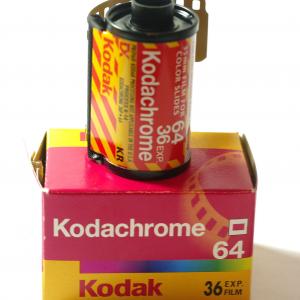Kodachrome was the film love of my life. Now that love story is over. The last roll has been produced--and shot and processed.
I used to shoot a lot of Kodachrome. Back when I ventured from B/W to color I opted for slides since they were less expensive to develop than color prints. In general I wasn't impressed with color prints. The ones that I saw were generally sub par with regards to exposure and colors. Slides seemed much better.
And sure enough: Kodachrome 25 and Kodachrome 64 were stunning films producing excellent images, sharp and with great color.
The very last roll of Kodachrome ever produced has now been shot and developed. It was shot by Steve McCurry, famous for the National Geographic "Afghan girl" cover. The shooting of the last roll produced by Eastman Kodak was also a National Geographic project, and the process was documented for the magazine from production to development and image review. The article will most likely appear in the magazine in early 2011.
Read the story in Wichita Eagle (of all places).
There's a gallery from the processing (which seems to be gone now).
You can also get the story on National Public Radio.
McCurry hits the head on the nail when he characterizes the film: "It has such a wonderful color palette ... a poetic look, not particularly garish or cartoonish, but wonderful, true colors that were vibrant, but true to what you were shooting."
I loved the colors and the style of Kodachrome. And the sharpness of course!
I remember when I switched to Ektachrome because Kodachrome was becoming too difficult to get processed. I was very dissatisfied with the colors, which seemed very unsaturated and a bit pale compared to the dense and bright colors of Kodachrome. I didn't find anything like it ever, only getting close with Fuji Provia 100, which I found to have just a bit of the subjective qualities that I liked so much in the Kodachrome.
The technology used in Kodachrome was different from other slide films. The Kodak film used dyes, which were substituted into the film during processing. Other films use socalled dye couplers, and without these in the emulsion Kodachrome film is thinner, and the developed film has a clearly visible relief of the image, which can be seen when light is reflecting in the slide.
And one last thing: the speed. Or lack of same. Today we're talking 200 ISO as slow and complaining if the cameras don't deliver at 400, 800 and 1,600 ISO. If you own a D3 or a D700, 3,200 and 6,400 isn't all bad.
Well, with Kodachrome you could choose between 64 and 25 ISO. That's sixty-four and twenty-five with no zeroes! So for speed you chose 64 ISO and for quality it was 25. And the quality and sharpness was amazing at both speeds.
On one side I do miss the slides, especially with the obvious qualities of Kodachrome, but on the other hand I have let go of film a long time ago and never looked back.
Much more about this fantastic film on Wikipedia and a bit more about me and Kodachrome in this article on scanning.




